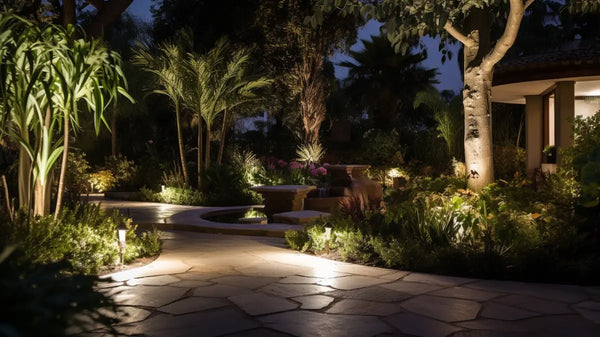Landscape Lighting: Choosing Between Uplighting and Downlighting

Landscape lighting is essential to creating a beautiful and functional outdoor space. It enhances the aesthetic appeal of your landscape and improves its safety and security. When it comes to landscape lighting, two popular options that you can consider are uplighting and downlighting. Understanding the difference between these two types of lighting can help you decide which one to choose for your outdoor space.
Understanding Uplighting and Downlighting
Uplighting Explained
Uplighting refers to lights placed at ground level and directed upward to illuminate specific features of your landscape. This type of lighting is commonly used to highlight architectural features, trees, and garden structures. Uplights are typically installed at the base of a tree or architectural column and are designed to cast light upward, creating a dramatic effect.
Downlighting Explained
Downlighting, however, involves placing a light fixture overhead to cast light downward onto the desired area. This type of lighting is commonly used to illuminate pathways, outdoor seating areas, and patios. Downlights are typically mounted on elevated surfaces such as trees, pergolas, or the exterior walls of your house.
The Difference Between Uplighting and Downlighting
The main difference between uplighting and downlighting lies in the direction of the light. Uplighting casts light upward, while downlighting casts light downward. This difference in direction creates distinct visual effects and allows you to achieve different lighting design goals in your landscape.
Uplighting is often used to create a focal point and draw attention to specific areas of your exterior. By subtly illuminating architectural features and garden structures, uplighting adds depth and interest to your landscape. On the other hand, downlighting provides ample light for functional purposes. It is commonly used to light up pathways, outdoor seating areas, and patios, ensuring visibility and safety.
When to Use Uplighting
Uplighting Trees
Uplighting trees can create a stunning effect, especially when the branches and leaves are illuminated from below. This technique adds a touch of elegance and drama to your landscape, making trees a focal point even at night. Uplighting can highlight both large, mature trees and smaller ornamental trees.
Uplighting Architectural Columns
If you have architectural columns or pillars in your outdoor space, uplighting them can add a sense of grandeur and sophistication. By casting subtle lighting along the columns, you can create a visually appealing effect that enhances the overall ambiance of your landscape.
Uplighting Garden Features
Uplighting can highlight various garden features such as statues, fountains, and water. By placing a fixture at the base of these features and directing light upward, you can create a mesmerizing effect that enhances the beauty of your garden.
When to Use Downlighting
Downlighting Low Growing Garden Plants
If you have low growing garden plants or ground-covering foliage, downlighting can be an excellent choice. By installing lights overhead and directing the light downward, you can create a soft and subtle glow that highlights the texture and colors of these plants.
Downlighting Outdoor Seating
Downlighting is a great option for outdoor seating areas such as patios, decks, or gazebos. By installing lights overhead and directing the light downward, you can create a cozy and inviting atmosphere for your outdoor gatherings. Downlights can be mounted on pergolas, trees, or the exterior walls of your house.
Downlighting Patios
Downlighting is the way to go if you want to illuminate your patio area for both aesthetic and functional purposes. By installing lights overhead and directing the light downward, you can ensure that your patio is well-lit and safe for nighttime activities. Downlights can be placed on pergolas, trees, or the exterior walls of your house.
When to Use Moonlighting
Moonlighting on Patios
Moonlighting is a type of downlighting that mimics the soft and natural illumination of the moon. It involves placing lights high in trees or elevated structures to cast gentle, downward light. Moonlighting on patios can create a magical ambiance, especially with other outdoor lighting techniques.
Moonlighting near Swimming Pools
Moonlighting near swimming pools can create a tranquil and serene atmosphere. By casting soft, downward light on the pool area, you can enhance its beauty and create a relaxing environment for evening swims or poolside gatherings.
Moonlighting on Driveways
Moonlighting can also be used to illuminate driveways and walkways. By placing lights high up in trees or on elevated structures, you can create a subtle, moonlit effect that guides people safely along the path.
Finding the Right Balance
In some cases, using a combination of uplighting and downlighting can achieve the best results. For example, uplighting can highlight architectural features and trees, while downlighting can provide functional lighting for pathways and seating areas. You can create a visually stunning and functional outdoor space by finding the right balance between these two lighting techniques.
The Benefits of Uplighting and Downlighting
Both uplighting and downlighting offer unique benefits that can enhance your landscape. Uplighting creates a sense of drama and draws attention to specific features, while downlighting provides ample light for functional purposes. Using both techniques strategically, you can create a well-balanced lighting design that adds beauty, safety, and security to your outdoor space.
Getting Started with Landscape Lighting
Contacting a Landscape Lighting Professional
To ensure that you make the most of your landscape lighting, it's best to consult with a landscape lighting professional. They can assess your outdoor space, understand your lighting goals, and recommend the best lighting options. A professional can also ensure that the installation is done correctly and that all safety measures are followed.
Conclusion
When it comes to landscape lighting, choosing between uplighting and downlighting depends on your specific lighting goals and the areas of your exterior that you want to highlight. Uplighting is ideal for creating focal points and drawing attention to architectural features and garden structures. Downlighting is perfect for providing functional lighting for pathways, seating areas, and patios. You can create a stunning and well-lit outdoor space by understanding the differences and benefits of these two lighting techniques.
